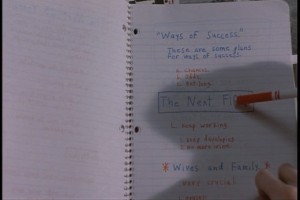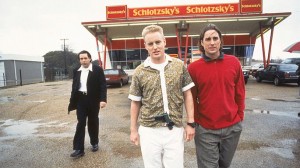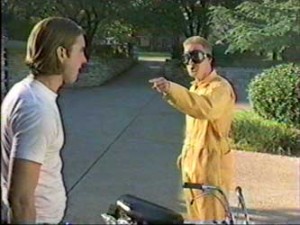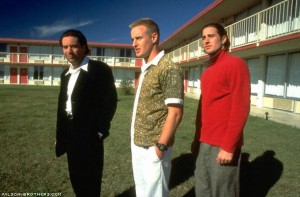First off, huge hat tip to my boy JB (the award-winning home-brewer and all around great man) for bringing this amusing, and somewhat touching piece to my attention. It seems there is an effort afoot to save the Texas motel that served a vital role in the Wes Anderson masterpiece Bottle Rocket. Check out the story (and, if you are in Texas –or if you are nuts enough to care this much– get involved directly).
In the meantime, it seems appropriate to revisit my review of Anderson’s epic (if still under-appreciated) debut. What better movie to fire up on this great American holiday weekend, right?
The perfection of Wes Anderson’s first film Bottle Rocket might lie in the fact that is isn’t, and wasn’t necessarily intended to be, a perfect film. Anderson tried to make perfect films later on (he failed with The Royal Tenenbaums, but came as close as any director can come with Rushmore), yet nothing he’s done since has been as oddly affecting as his debut feature.
Part of the desperate charm of this “little” film can be attributed to its convoluted origins: the 13-minute short (directed by Anderson and co-written with college friend Owen Wilson) premiered at the Sundance Film Festival and attracted certain appropriate, important people. Despite the subsequent involvement, and unflagging endorsement of James L. Brooks (The Simpsons), the final script needed more time in the oven and more than a little TLC to get it ready for the big screen.
Despite the cast and crew’s understandable confidence in what they ended up with, the initial test screenings were catastrophic, and Sundance inexplicably refused the full-length version of the film it had previously championed. Disillusioned but not defeated, Anderson and Wilson went back to the drawing board and (wisely) rewrote and reshot the entire beginning of the film. Their perseverance paid off. What could (and would) have, at best, been hailed (and/or discarded) as a cute, quirky effort instead arrived—-after several years and more than a handful of detours—-as a polished product, and a damn near perfect film.
All of that back-story is essential in order to properly appraise the not exactly auspicious evolution of this film. It also serves as (yet another) case study of how even the feel-good, left-field success stories are often only the final step in an arduous, sometimes painful artistic process. More importantly, the evidence of these two friends’ unflappable natures underscores how their project came to fruition, and where the eccentric energy permeating the movie derives from.
Since lightning won’t strike in the same place twice, it was a wonderful, albeit necessary happenstance that a first time director was working with a first time script with first time actors. Part of the innocent seduction people talk about when they talk about how they fell for this film is in no small part due to these aforementioned circumstances. In short, this balance of earnestness and ambition could never be duplicated by a veteran who has lived through the meat-grinding process of making a movie.
Now that Bottle Rocket is getting the Criterion Collection treatment, its status is officially elevated from cult-following to sanctified. Given its complicated history and the fact that it almost failed to make it out of the starting gate, what can we say, today, to elucidate how it (almost) flopped, and why it endures? Here is Martin Scorsese (taken from the DVD booklet, quoted from an appreciation of Anderson he wrote for Esquire in 2000): “A picture without a trace of cynicism that obviously grew out of its director’s affection for his characters in particular and for people in general. A rarity.” Bottle Rocket is indeed a rare type of movie: unimprovable casting, impeccable soundtrack (Anderson’s first fruitful collaboration with the amazing Mark Mothersbaugh), and the creation of a world that is at once disarmingly peculiar and utterly unique.
And the plot? Well…that may explain why a majority of the movie’s first viewers walked out of the theaters. And it certainly explains the typical, and predictable, critical indifference that the film generally received. The plot, such as it is, involves an increasingly outlandish series of escapades, masterminded by Dignan, the ringleader who is all heart and not exactly what one would call a masterful mind. But the plot (as, I would argue, is so often the case with some of our more influential, if unappreciated film and fiction) is mostly a delivery device for the characters.
And, as is the case with all Wes Anderson’s films, the characters are a delivery device for the Wes Anderson aesthetic. This sensibility was still fresh and unfettered at this stage, and its propensity for preciousness, while for the most part deftly avoided in Rushmore, is in full effect throughout The Royal Tenenbaums. Bottle Rocket is, to be certain, very much a statement of purpose and a signal of things to come, just as Christopher Nolan’s Following–for instance—-is replete with images and obsessions that would come to the fore in his brilliant follow-up, Memento.
In the film’s opening scene, Anthony (the almost indescribably likeable Luke Wilson) is ending his voluntary stay at a mental hospital, and his doctor admonishes him “don’t try to save everyone.” Enter Dignan, his best friend and imminent partner in crime. Dignan has been convinced (or has convinced himself) that he is helping bust Anthony out, and Anthony willingly plays along. While on the bus ride back home, we see the “75-Year Plan” Dignan has drawn up for them—-a detailed exercise that is, like its author, at once endearing and exasperating.
Dignan’s immediate mission is to prove that crime does pay, and the moment they return, they go to work. Their first heist, a robbery, is a success, albeit a quick one that yields a rather underwhelming bounty. Nevertheless, Anthony is caught up in the excitement, until he realizes that Dignan helped himself to his mother’s earrings, which were strictly off limits. And at this point the viewer understands that all they did was “rob” Anthony’s parents’ house. These small-time hoods, it seems, aren’t quite equipped to leave their own ‘hood.
After they recruit their other friend (the impeccably named Bob Mapplethorpe) as a getaway driver—-a role he is ideally qualified to perform, as he is the only one of them who owns a car—-they knock off the local bookstore. Another success and, in Dignan’s romanticized depiction, they are henceforth “on the run from Johnny Law.” Whether they are exactly wanted men is, at this point, a dubious proposition, but off they go, regardless.
Of course, when they pass a fireworks stand on their way out of town, they immediately pull over to load up on bottle rockets. While this scene obviously gives the movie its title, it also provides its theme: these young men are clearly not ready (or willing) to embrace adulthood, so they engage in what they perceive—-from watching too many movies—-to be dangerous, authentic activities, yet they can’t resist the urge to stop when they see a chance to buy firecrackers. This scene also provides one of the many masterful Andersonian touches that subtly conveys the innocence and absurdity of their adventure. Firing bottle rockets out of a moving car is not exactly the ideal way to avoid detection, just like Dignan’s subsequent vision of matching yellow jumpsuits for their penultimate gig is…not quite the signal of an advanced criminal acumen.
Getting back to the issue of plot, it is never much in question that these rascals will fail in their quest to become legitimate thieves, it is only a matter of how spectacularly they will flame out (and for those who have not seen the movie, the denouement is at once appropriately over-the-top and indelible). But the actual payoff is all about the journey, and the somewhat refreshing resolution of lessons not necessarily learned.
Through their experiences, Bob manages to reconnect, however tentatively, with his bullying older brother. Anthony happens to meet the woman of his dreams, in a whirlwind courtship that manages, against all probability, to unfold in a fashion that is convincing and tender. Most significantly, Dignan comes closer to achieving, or at least understanding, his destiny. Or does he? He may not be in a different place by the time the action ends, but the viewer definitely is.
How does this happen? One explanation is that different viewers of this film could come up with any number of different scenes that encapsulate the entire story. And each person, each scene, would be the right one. An example: as they plan the make-or-break heist, while Dignan reviews his painstakingly prepared notes, Anthony completes, with an artistic sort of absentmindedness, a flip book of a figure poll vaulting (which, in its way, is equally painstakingly prepared). Genius in movies lies in the details, and the details in this extremely short scene are immaculate. Dignan with coat and tie, signifying he is in full business mode, albeit with his horrific white athletic socks—-the ultimate not-ready-for-primetime oversight. Anthony, listening patiently while Dignan checks off his list, right there by his friend’s side, but not entirely there. These few moments crystallize their personalities, and the dynamic of their very genuine friendship, in ways it would take dozens of pages in a very good book to convey.
Later, after the heist has gone predictably, hysterically astray, the cohorts visit Dignan at the state penitentiary, where he has traded in his yellow jumpsuit for a white prisoner’s model. A moment follows that hits the trifecta for writing, acting and directing: Dignan pulls out a pile of belt buckles he has handcrafted and offers them around. It turns out the other, absent, accomplices (including Mr. Henry, played by tough-guy extraordinaire James Caan) whom he made buckles for might be partially responsible for landing him in jail, but he shrugs his shoulders and says there are no hard feelings. There has never been a character like Dignan in any movie, before or since.
That this restored high definition transfer is now available amounts to a win/win for fans or would-be first time viewers: anyone not yet convinced can likely pick up an older version of the DVD dirt cheap; repeat customers can treat themselves to an upgrade that truly looks and sounds stellar—an obvious technical improvement on the original.
And then there’s the bonus material. The film has commentary provided by Anderson and Owen Wilson; they are both exceedingly soft-spoken and humble about their collective accomplishments, but their insights are, well, insightful. Suffice it to say, Anderson (and/or Wilson) aficionados will want to savor this stuff.
Sample nugget: Owen initially resisted the idea of playing the role he helped write, because he didn’t feel he was “legit”; fortunately for everyone, Anderson was able to convince him otherwise. The bonus disc offers everything from a making-of documentary (including hilarious input from most of the cast, including James Caan), behind-the-scenes photos taken by sister Laura Wilson (this project truly keeps it all in the family!) and, above all, the original 13-minute short film, from 1992, that first lit the fuse.





